
I don’t usually review movies, but Martin Scorsese’s Killers of the Flower Moon is a perfect film for audiences to take in this National American Indian Heritage Month. Adapted from the 2017 book by David Grann, this superb picture may well result in the first-ever Best Actress win for a woman of Native descent, the extraordinary Lily Gladstone. It’s also an all-too-rare artistic collaboration between Hollywood and a Native community that offers crucial lessons in its narrative design about embracing diverse perspectives and the importance of authentic representation.
From its opening moments, Killers celebrates the traditions of Osage culture and portrays the burdens the Osage have faced. Displaced from their ancestral lands and relocated to a presumably worthless reservation in Oklahoma, their children forced into boarding schools that rob them of their language and culture, the Osage lament the end is near. But, suddenly, their new home is flush with oil, and by the 1920s, the Osage become the wealthiest people per capita in the world. This makes them targets for greedy white criminals, who conspire to take everything from the Osage once again.
The film’s moral center is Mollie (Lily Gladstone), an Osage woman whose family owns precious “headrights” to the oil-rich land below. Mollie and her sisters know their many white gentlemen callers want their land. Nonetheless, Mollie slowly grows fond of Ernest Burkhardt (Leonardo DiCaprio), a simple fellow who works for his wealthy uncle (Robert DeNiro). But as the “Reign of Terror” unfolds, and hundreds of Osage are murdered for their newfound wealth, Mollie comes to realize Ernest is not as naive as she hoped.
Even beyond the gruesome murders, the matter-of-fact ways Osage face daily discrimination are extremely disturbing. Except when Molly and her sisters are being courted, white characters in this film rarely treat the Osage with human dignity. For example, they cannot just access their family money; they must beg for it from white bankers who control the funds because the law says the Osage are incompetent. (The Osage even had to declare themselves thus as part of the degrading deal.) They are also routinely overcharged huge markups – “Osage prices” — for goods and services simply because of their ethnicity.
Because whites had long viewed Native Americans as beneath them, they felt little compunction about stealing from and even killing their Osage neighbors on a regular basis. The stereotypes whites used to justify horrible misdeeds against the Osage were not only firmly embedded in federal law – they were older than the American Republic. After all, in the same Declaration where Thomas Jefferson declared “all men were created equal,” he also railed against “the merciless Indian Savages.” When negative stereotypes are buried deep in our culture, it takes an act of will – or love – to overcome them.
Killers also reminds us that the Osage are not alone in facing systematic prejudice, discrimination, and even mass murder in the 1920s. The revived Ku Klux Klan is gaining sizable political footholds in many states by attacking African Americans and ethnic whites. Another wealthy community of color just 40 miles away gets destroyed at precisely the same time when hundreds of African Americans are slaughtered and “Black Wall Street” burns in the 1921 Tulsa Massacre.
In its narrative and production, Killers attempts to rectify some of these longstanding discriminatory narratives about American Indians. Too often, even films that aim to celebrate Native American stories, such as Little Big Man, Dances with Wolves, or Last of the Mohicans, still have a white savior at their center. At first, Killers was going to follow the pattern: the script originally focused on Tom White, a Bureau of Investigation agent (to be played by DiCaprio) who eventually helped solve the murders. But, over time, Scorsese and DiCaprio wisely realized the Osage must be the heart of the story. (White remains in the film, played by Jesse Plemons, but in a much smaller role.)
One of the reasons Killers turned out so well is because the Osage were integral members of the production both on- and off-camera. After heartily agreeing to film in Oklahoma, Scorsese, DiCaprio, and Gladstone worked closely with descendants of the Osage victims and the Osage Nation to get the story and the cultural nuances right. “The respect that Mr. Scorsese and his team have displayed toward us is more than we hoped for,” said Osage Chief Standing Bear. “They listened, that was the biggest thing,” agreed Brandy Lemon, a member of the Osage Nation Congress. “They actually listened to us. We weren’t considered what people say ‘token Indians.’ They saw us as people.”
That said, not everyone agrees the film is entirely successful at centering the Osage experience. While Scorsese “did a great job representing our people,” said Christopher Côté, a language consultant on Killers, “I really wanted this to be from the perspective of Mollie and what her family experienced. But I think it would take an Osage to do that…This history is being told almost from the perspective of Ernest Burkhart, and they kind of give him this conscience and kind of depict that there’s love. But when somebody conspires to murder your entire family, that’s not love… that’s just beyond abuse.”
Gladstone, an actress of Blackfeet descent, notes that’s a fair criticism. “Marty is a titan, but he’s not bigger than history,” she told Variety. “It’s the tricky nature of a story like this…you have to be very aware of the film that you’re watching and what lens it was made through.” Scorsese also likely agrees, judging from the haunting closing of Killers, which I won’t spoil here. Even when done in good faith, it suggests that our narratives about other people can mislead or perpetuate bias.
Ultimately, there are inherent limits to how much we can do justice to someone else’s story.
Killers works best when it centers on the diverse Americans whose history is portrayed, restores their essential humanity, lets the Osage lead on how they are represented, and recognizes the limitations of trying to speak for them.
These are lessons business leaders should take to heart. According to the 2020 Census, 3% of Americans are American Indian or Alaska Native (AIAN), and that’s probably an undercount. But they still only make up less than 1% of S&P 500 boards. “Sometimes, when people are citing different groups in a diversity conversation, they don’t even mention Native Americans,” notes American Bar Association president Mary Smith (the first Native woman in that role). “They get overlooked entirely. It’s important to ensure that they’re included.”
Similarly, most companies understand that embracing diversity is necessary for success, especially if they aim to truly connect with consumers from various backgrounds. But too often in corporate America, companies don’t lead with diversity in the stories they tell about themselves and their values because of an overwhelming fear of getting it wrong and facing market consequences as a result. By reaching out to communities of color and letting them lead the conversation about their portrayal, Killers of the Flower Moon demonstrates a powerful path forward from which we can learn.


